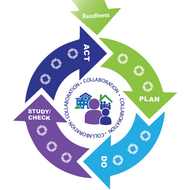Addressing the root causes of disparities in school discipline
(View Complete Item Description)Stage 1: Digging Into the Data addresses the question “Do disparities in school discipline exist in our school or district?” The guide provides a set of tasks to help determine your data needs, harvest the data you already have at your disposal, identify additional data you may need, disaggregate and analyze your data, and then develop preliminary findings. Stage 2: Getting at the Roots of Disparities addresses the question “What are the root causes of our disparities in school discipline?” You will learn how to dig deeper and conduct a root cause analysis to understand why disparities exist in your discipline outcomes. Stage 3: Creating an Action Plan addresses the question “How will root causes of disparities in school discipline be addressed?” This stage walks you through developing an action plan for eliminating the disparities discovered in your root cause analysis that can be implemented, monitored, and continuously improved over time. The guide includes a Disciplinary Disparities Risk Assessment Tool to aid in data gathering and analysis. The tool contains a series of Microsoft Excel–based worksheets, with detailed instructions on the kind of data to gather and how to analyze your results using a set of key questions. The tool automatically generates visual data displays to enhance analysis. This tool can be used as-is, modified, or serve as a model for designing a tool that can integrate with or import data from an existing school or district database or student management system. The tool also can be used in concert with existing data collection efforts, such as those connected with positive behavioral interventions and supports (PBIS). The guide also includes the following: • Templates to help plan and facilitate communication among stakeholders; • Real-world examples from schools and districts already experiencing success; • Sidebars and tip sheets to extend knowledge; • Links to useful resources; • Strategies for doing a thorough job without getting bogged down; and • Tips for undertaking tough conversations.
Material Type: Other

















